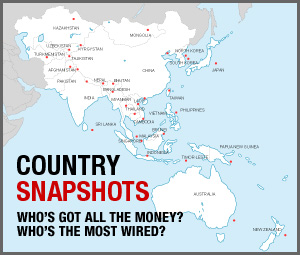APAC—Top 10 Stories of Decade
2. War in AfghanistanOctober 7, 2001 –
Prior to September 11, 2001, Afghanistan was in the grip of the Taliban, a hard-line Islamic regime with a 9th century perspective on human rights, known to be harbouring Osama bin Laden yet barely registering on the world’s news radar. But within weeks of the attacks on America, the Taliban had been ousted from power by an international coalition dominated by a smallish US force of mostly elite soldiers working with anti-Taliban tribal leaders. Yet despite a devastating show of US force, Taliban leader Mullah Omar slipped away (he is believed to be in Quetta) and bin Laden is thought to have escaped during the battle at Tora Bora. And with Washington’s attention diverted by its disastrous adventure in Iraq, the Taliban has since regrouped from its new base in Pakistan’s wild northwest.
By the time incoming US President Barack Obama began prosecuting ‘the right war’, he faced what many observers believe is an unwinnable situation, with beleaguered US soldiers propping up a corrupt regime and ineffectual local military from Kabul while the Taliban consolidates gains throughout much of the rest of the country. As if to prove the maxim that generals always fight the last war, the approaches that worked (sort of) in Iraq have been imported almost wholesale–think ‘COIN’ and ‘surge’–and supported by Obama in an unconvincing plan announced after much cogitation late in 2009. With the support of Pakistani intelligence, the US has at least had some notable successes in strikes against the al-Qaeda leadership, with the first-ever widespread (and controversial) deployment of unmanned aircraft. There’s too much at stake here for Washington to contemplate an easy exit, and Obama’s call for a 2011 drawdown may be unrealistic. All of which means US Vice President Joe Biden’s preference for a more narrowly defined strategy in the region–just go after al-Qaeda–could look more attractive as the new decade goes on.











